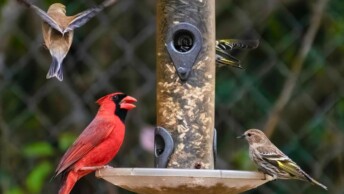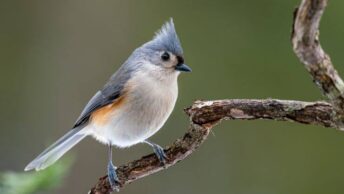Illinois is home to a remarkable array of falcons, each species bringing its own unique charm and awe-inspiring presence to the skies. From the agile American Kestrel, known for its graceful hovering hunts, to the mighty Peregrine Falcon, celebrated as the fastest bird in the world, these raptors captivate birdwatchers and nature enthusiasts alike.
During migration, the elusive Merlin and the striking Prairie Falcon add to the state’s avian diversity, while the rare winter visits from the majestic Gyrfalcon make for an extraordinary sight. Join me as we explore the fascinating lives and habitats of these incredible birds of prey, uncovering the secrets of their survival and their vital role in the ecosystem of Illinois.
1. Peregrine Falcon
- Scientific name: Falco peregrinus
- Life span: 8-15 years
- Size: 14-19 inches (36-48 cm)
- Weight: 1.1-3.3 pounds (500-1500 grams)
- Wingspan: 3-4 feet (90-120 cm)
- Status: Least Concern
- State status: Breeding and common
The Peregrine Falcon, renowned as the fastest bird in the world, is a fascinating raptor with a broad geographical range. Found on every continent except Antarctica, this bird is a familiar sight in Illinois, especially during migration periods. Peregrine Falcons are known for their impressive hunting dives, reaching speeds over 200 miles per hour.
They are characterized by their blue-gray back, barred white underparts, and a distinct dark hood and sideburns. In urban areas, these falcons have adapted well, often nesting on skyscrapers and bridges, providing an urban counterpart to their traditional cliffside nesting sites.
The recovery of the Peregrine Falcon population, once endangered due to DDT poisoning, stands as a significant conservation success story, ensuring that these magnificent birds continue to grace the skies of Illinois and beyond. They’ve recently made a huge recovery in my home country of Denmark, and the newest number suggests 20 breeding pairs, compared to 0 in 2001.
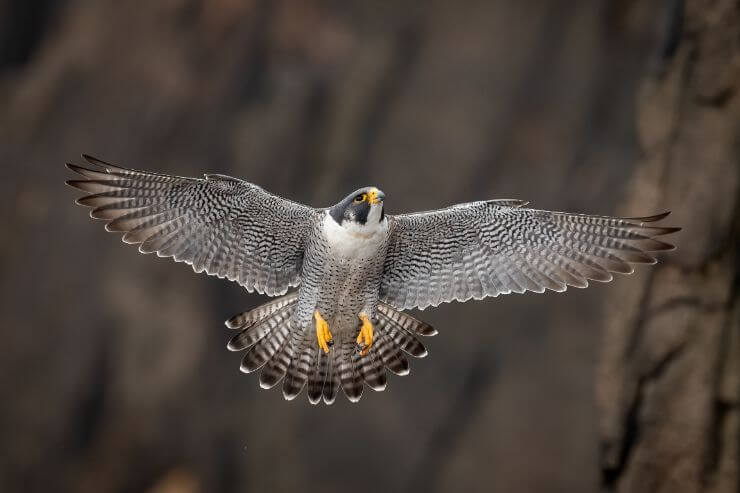
Peregrine Falcons in Illinois are known for their impressive nesting sites, often choosing high cliffs or tall urban structures such as skyscrapers and bridges. These sites provide safety and a broad hunting range. The female lays three to four eggs in a simple scrape on a ledge, which offers protection from predators.
Both parents share the incubation duties, with the male typically taking the day shift. This strategic nesting behavior ensures the survival of their young in the diverse landscapes of Illinois, from cityscapes to natural cliffs.
In Illinois, Peregrine Falcons primarily prey on birds, making use of their incredible speed and agility to catch pigeons, ducks, and other medium-sized birds. Their hunting technique involves a dramatic dive, known as a stoop, where they can reach speeds of over 200 miles per hour. This breathtaking hunting style not only showcases their prowess but also plays a vital role in controlling the populations of their prey species, maintaining the ecological balance in their habitats.
The conservation story of the Peregrine Falcon in Illinois is one of remarkable recovery. Once nearly wiped out by pesticide poisoning, particularly from DDT, their numbers dwindled dangerously low. Intensive conservation efforts, including the banning of DDT, captive breeding programs, and habitat protection, have helped their population rebound.
Today, Peregrine Falcons are a symbol of successful conservation, with many nesting pairs now thriving in urban areas across Illinois, bringing these magnificent birds back from the brink of extinction.
2. Prairie Falcon
- Scientific name: Falco mexicanus
- Life span: 7-10 years
- Size: 14-18 inches (35-45 cm)
- Weight: 1-2 pounds (450-900 grams)
- Wingspan: 35-43 inches (89-110 cm)
- Status: Least Concern
- State status: Migratory and rare
The Prairie Falcon, with its distinctive pale and sandy-brown plumage, is a fascinating sight in the open landscapes of Illinois, particularly during the winter months. This bird prefers arid environments such as grasslands, deserts, and agricultural fields, making it less common but notable when seen in Illinois.
Prairie Falcons are marked by their white eyebrows, mustache stripes, and heavily spotted underparts, creating a beautiful contrast against their lighter, sandy backgrounds. These falcons are well-adapted to life in expansive, open areas, often seen gliding effortlessly over the plains.
Their presence in Illinois, especially in the southern parts during migration and winter, offers a unique glimpse into the adaptability and resilience of these remarkable birds of prey.

Prairie Falcons often chose open, arid landscapes when nesting. They often nest on cliffs or rocky outcrops, creating a simple scrape on the ground or ledge. The female lays her eggs in this shallow depression without adding any nesting materials.
Both parents share incubation duties, and they are known for their aggressive defense of the nest site. This nesting strategy is well-suited to their preference for wide-open spaces, offering both visibility for hunting and protection from predators.
Prairie Falcons have a diverse diet that includes small mammals, birds, and insects. In Illinois, although rare, they hunt in open areas, preying on ground squirrels, songbirds, and occasionally reptiles. Their hunting technique involves swift, low flights over the ground, striking their prey with speed and precision.
This method reflects their adaptability and skill as hunters, maintaining the balance of prey populations in their habitat. The presence of Prairie Falcons adds a unique dimension to the avian biodiversity of Illinois.
Conservation efforts for Prairie Falcons focus on protecting their natural habitats and ensuring an ample food supply. In Illinois, where they are rare, conservation programs still monitor their presence and support habitat preservation. Historically, these falcons have faced threats from habitat destruction and human disturbance.
Efforts to mitigate these threats include creating protected areas and reducing pesticide use. Though not a common resident, the conservation of Prairie Falcons in Illinois is part of broader initiatives to protect all raptor species and their environments.
3. Gyrfalcon
- Scientific name: Falco rusticolus
- Life span: 15-20 years
- Size: 20-25 inches (51-64 cm)
- Weight: 2-4 pounds (900-1800 grams)
- Wingspan: 3-4 feet (90-120 cm)
- Status: Least Concern
- State status: Migratory and rare
The Gyrfalcon, the largest of the falcon species, is a rare but majestic visitor to Illinois, typically seen only during the winter months. Originating from the Arctic and sub-Arctic regions, this powerful raptor is a symbol of strength and endurance. Gyrfalcons display a range of color morphs, from pristine white to dark gray and black, with intricate speckling that adds to their impressive appearance.
Their large size and robust build distinguish them from other falcons, making any sighting in Illinois a significant event for bird enthusiasts. These birds favor cold, open habitats and are usually found in tundra regions, but during winter, some individuals venture further south, bringing a touch of Arctic grandeur to the Illinois landscape.
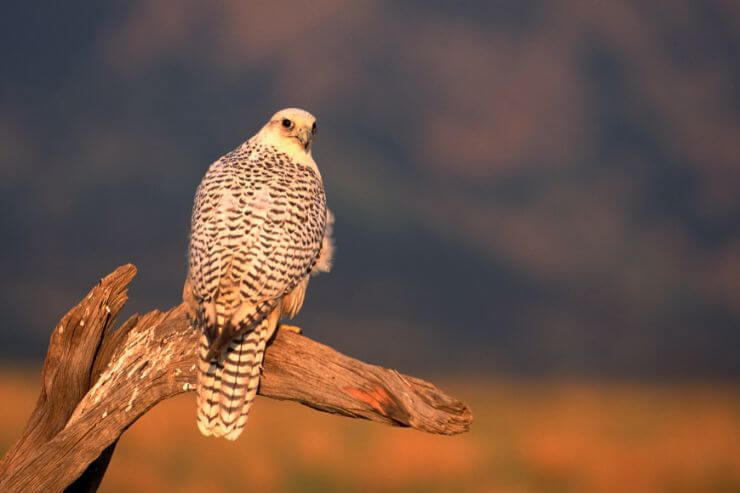
The Gyrfalcon, primarily an Arctic species, is a rare but awe-inspiring visitor to Illinois, typically seen during winter. These falcons prefer nesting on high cliffs or in large trees, creating nests from sticks and other materials, lined with softer elements. In their native range, they often choose remote, rugged terrains, reflecting their adaptability to harsh environments.
The female lays two to four eggs, and both parents share incubation duties. In Illinois, their nesting behavior remains a subject of interest, although sightings are infrequent.
Gyrfalcons have a broad diet that includes birds and mammals, often preferring larger prey. In Illinois, during their rare winter visits, they might hunt ducks, ptarmigans, and hares. Their powerful and direct hunting style allows them to catch larger prey than most other falcons. This adaptability in diet ensures their survival in various habitats, including the tundra regions of their primary range. The presence of Gyrfalcons in Illinois, though rare, is a significant event for bird enthusiasts, highlighting the state’s diverse avian life.
Conservation of Gyrfalcons involves protecting their Arctic habitats and monitoring their populations for any signs of decline. In Illinois, their rare presence during winter is carefully noted by conservationists. Historically, Gyrfalcons have been less affected by human activities compared to other raptors, but climate change poses a significant threat to their habitats.
Efforts to conserve Gyrfalcons focus on mitigating the impacts of climate change and ensuring the protection of their remote nesting and hunting grounds. Their occasional appearance in Illinois underscores the importance of comprehensive conservation strategies.
4. American Kestrel
- Scientific name: Falco sparverius
- Life span: 5-10 years
- Size: 8-12 inches (20-30 cm)
- Weight: 2.8-5.8 ounces (80-164 grams)
- Wingspan: 20-24 inches (51-61 cm)
- Status: Least Concern
- State status: Breeding and common
The American Kestrel, also known as the sparrow hawk, is a small but vibrant falcon found throughout the Americas. This bird is a common sight in Illinois, particularly in open areas like grasslands, farmlands, and urban settings. With its striking plumage, the American Kestrel is easily recognizable. Males boast slate-blue wings and a rusty-red back and tail, while females display a more subdued reddish-brown coloration with black barring.
Both genders have a distinctive double black stripe, or “mustache,” on their faces. This species exhibits remarkable adaptability, thriving in a wide range of environments from the southern tips of South America to the northern reaches of Canada. Their ability to hover while hunting and their acrobatic flight patterns make them a delightful spectacle for birdwatchers.

In Illinois, American Kestrels prefer nesting in open areas such as grasslands, farmlands, and urban outskirts. They often use tree cavities, abandoned woodpecker holes, or even man-made nest boxes for their nests. The female lays around four to five eggs, and both parents are involved in the incubation process, though the female does most of the sitting.
Nesting sites are typically lined with soft materials to ensure the safety and warmth of the eggs. The sight of kestrels nesting is a common and delightful spectacle in various parts of Illinois.
American Kestrels in Illinois have a diverse diet that mainly includes insects, small mammals, and birds. Grasshoppers, crickets, and beetles form a significant part of their diet during the warmer months, while small rodents like mice and voles are more commonly hunted during colder periods. Their hunting technique is unique; they are often seen hovering in the air before making a swift dive to capture their prey. This method is not only efficient but also a fascinating display of their agility and precision in the wild.
Conservation efforts for American Kestrels in Illinois have been focused on habitat preservation and the provision of nest boxes. These initiatives help compensate for the loss of natural nesting sites due to urban development and agricultural expansion.
Historically, kestrel populations declined due to pesticide use and habitat destruction, but through dedicated conservation programs and public awareness, their numbers have seen a positive trend. These efforts are crucial in maintaining a stable population of this vibrant and adaptable species in Illinois.
5. Merlin
- Scientific name: Falco columbarius
- Life span: 5-10 years
- Size: 9-11 inches (23-28 cm)
- Weight: 5-7 ounces (140-198 grams)
- Wingspan: 20-26 inches (51-66 cm)
- Status: Least Concern
- State status: Migratory and rare
The Merlin is a small, fierce falcon that brings a touch of wildness to the Illinois landscape during its migration periods. This bird is marked by its varied coloration, depending on its geographic origin. In North America, the Merlin’s plumage can range from the dark blue-gray of the Taiga Merlins to the pale, dusty brown of the Prairie Merlins.
Regardless of color, they all share a robust build and a powerful flight. In Illinois, Merlins are typically seen during the winter months and migration, adding a dash of excitement to the season for birdwatchers. Their presence, though less common than other falcons, is always a notable event, as these birds exude a fierce, determined energy whether perched high in trees or swiftly darting through the air in pursuit of prey.
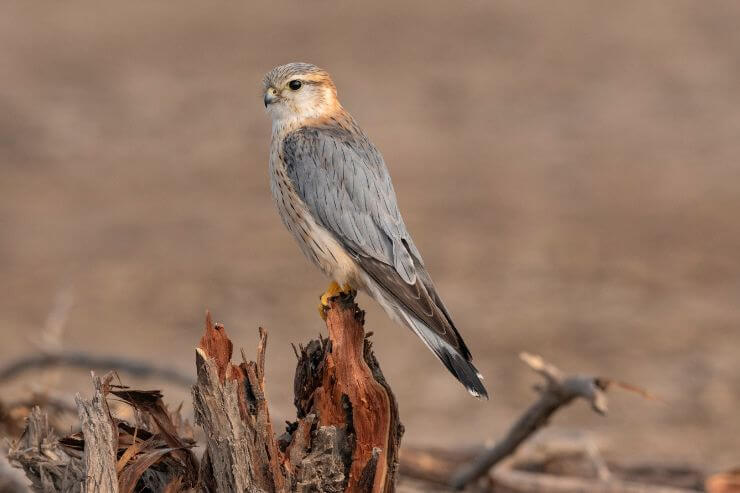
Merlins are small but fierce falcons that choose varied nesting sites. They often use abandoned nests of other large birds such as crows or hawks, usually located in coniferous forests or urban green spaces.
These falcons do not build their own nests but instead rely on these existing structures, occasionally lining them with twigs or leaves. The female lays four to six eggs, and both parents are actively involved in raising the young.
The diet of Merlins in Illinois is predominantly small birds, which they catch in mid-flight with remarkable speed and agility. They also eat insects and small mammals when their primary prey is scarce. Their hunting style involves high-speed chases, often catching their prey off guard.
This dynamic hunting behavior not only showcases their prowess but also helps control the populations of small birds and insects, contributing to the ecological balance within their habitats.
Merlins have benefitted from conservation efforts focused on habitat protection and pollution control. In Illinois, maintaining forested areas and reducing pesticide use have positively impacted their populations. Historically, Merlins faced challenges from habitat destruction and pollution, but their numbers have remained relatively stable compared to other raptors.
Ongoing conservation programs continue to monitor their populations and ensure that these agile falcons have safe and sustainable environments to thrive in Illinois.
Where to look for Falcons in Illinois
Finding falcons in Illinois is a thrilling adventure for bird enthusiasts. To spot these majestic birds of prey, timing and location are key. The best times are during migration periods in spring and fall, when falcons are on the move, although some species can be found year-round.
One of the top spots is the Starved Rock State Park, known for its dramatic sandstone canyons and river views. Peregrine Falcons often nest on the cliffs, providing an excellent vantage point for birdwatchers. Another great location is the Illinois Beach State Park, where the diverse habitat of dunes, marshes, and forests attracts a variety of falcon species, including the Merlin during migration.
The Mississippi Palisades State Park offers stunning bluffs overlooking the Mississippi River, a prime location for spotting Prairie Falcons and Peregrine Falcons. This park’s elevated trails give birdwatchers an expansive view of falcons in flight. Lastly, the Chautauqua National Wildlife Refuge is a hidden gem for birdwatching. Its wetlands and open water create a perfect hunting ground for falcons, particularly the American Kestrel.
To maximize your chances, bring binoculars and a field guide, and visit early in the morning or late afternoon when falcons are most active. Joining local birdwatching groups can also provide valuable tips and company on your falcon-spotting excursions.
Conclusion
Illinois is home to a fascinating array of falcons, each with unique behaviors and ecological roles. From the adaptable American Kestrel to the rare and powerful Gyrfalcon, these birds enrich the state’s biodiversity.
Conservation efforts have played a vital role in ensuring their survival and maintaining healthy populations. Observing these magnificent raptors offers a glimpse into the dynamic and resilient world of Illinois’ natural heritage, highlighting the importance of ongoing conservation initiatives.

